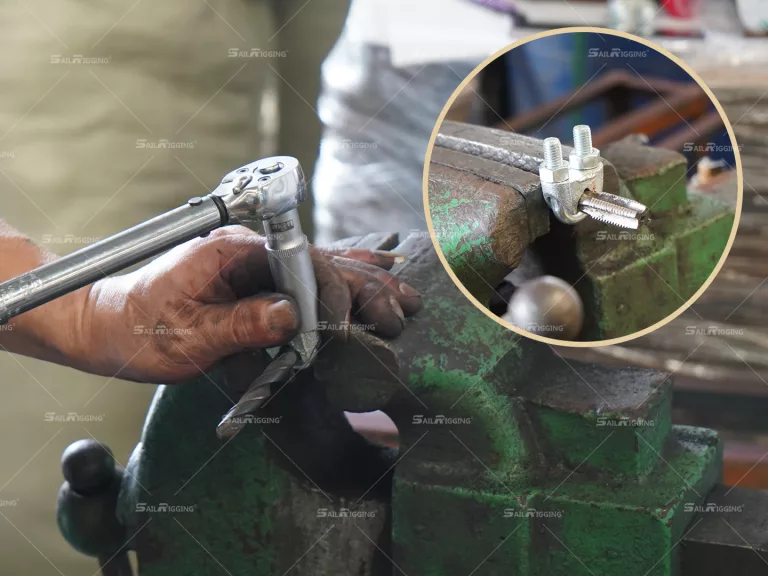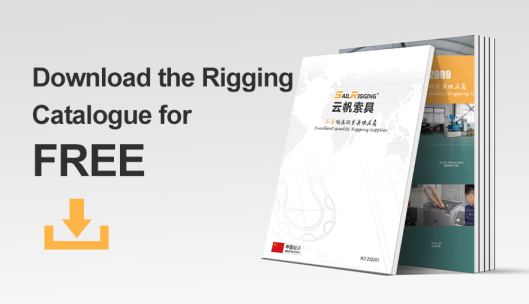Wire rope clips, known as wire rope grips, u bolt clips, cable clamps, bulldog clips, bulldog grips, are crucial components used to secure wire rope ends in various rigging, lifting, and industrial applications. Ensuring these clips are properly installed and torqued is critical for maintaining load security and preventing failures. A torque test helps us to verify if the wire rope clips are tightened to the manufacturer’s recommended torque specifications, which is essential for safety and performance.
This article will guide you through the process of performing a torque test on wire rope clips.
What is A Torque Test?
A torque test measures the amount of rotational force applied to a bolt, nut, or clip. For wire rope clips, this test ensures that the U-bolt clips and saddle clamp are securely fastened to the rope at the correct torque value. Proper torque is necessary to prevent slippage or loosening of the wire rope clip under load.
Step-by-Step Guide to Torque Testing Wire Rope Clips
1.Install the Wire Rope Clip Correctly
- Start by placing the wire rope clip on the wire rope according to the manufacturer’s instructions. The U-bolt should fit over the live end of the rope (the part carrying the load), and the saddle should be positioned on the dead end (the part of the wire rope that is not under tension).
- Install the number of wire rope clips recommended for the diameter of the wire rope. For example, larger wire ropes may require multiple clips.
2. Tighten the Nuts by Hand
- Once the wire rope clip is positioned correctly, hand-tighten the nuts to ensure that the saddle and U-bolt are properly seated.
3. Set the Torque Wrench
- Adjust your torque wrench to the specified torque value recommended by the wire rope clip manufacturer. Different sizes and types of wire rope clips will have different torque values, so it’s essential to follow these guidelines closely.
- As an example, a 1/2-inch wire rope clip may require a torque of 65 foot-pounds, but always verify the correct value for your specific clip.
4.Torque the Nuts
- Use the torque wrench to tighten each nut evenly, alternating between the two sides. Apply the wrench to each nut, slowly increasing the torque until the wrench clicks or signals that the set torque value has been reached.
- Avoid over-tightening, as this can damage the clip or wire rope and reduce its load capacity.
5.Perform a Second Tightening After Loading
- Once the wire rope is loaded, it is normal for the clips to settle slightly, which can loosen the nuts. After the initial loading, recheck the torque on each clip and re-tighten as necessary to the recommended torque setting.
- This second tightening is crucial to ensure the clip remains securely fastened during use.
6. Inspect the Installation
- After torqueing, visually inspect the installation to ensure that the clips are properly seated on the wire rope and that no excessive damage or deformation has occurred.
- Check that the wire rope is not crushed or excessively flattened by the U-bolt, as this can weaken the rope.
Additional Tips for Accurate Torque Testing
- Use calibrated tools:Ensure that your torque wrench is properly calibrated for accurate measurements. Using an uncalibrated tool may lead to improper torque and compromise safety.
- Follow the “never saddle a dead horse” rule:Always place the saddle of the wire rope clip on the live end of the wire rope, not the dead end.
- Check manufacturer specifications:Always refer to the specific instructions and torque values for the wire rope clip you’re using, as these vary based on the size, material, and type of clip.
Conclusion
Proper torque testing is a critical step in installing wire rope clips to ensure the safety and performance of your rigging systems. Torque testing wire rope clips is vital to prevent dangerous failures under load. If the clips are under-torqued, the wire rope may slip out of the clip, causing the load to fall. Over-torquing, on the other hand, can damage both the wire rope and the clip, reducing their overall strength. Ensuring that the clips are correctly torqued provides peace of mind that your rigging setup is safe and reliable. Following the manufacturer’s torque recommendations, using the right tools, and performing a recheck after loading will help guarantee that your wire rope clips are secure and capable of handling the intended load. If you have any question about torque test of wire rope clips, you could consult Sail Rigging right now.





